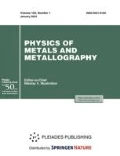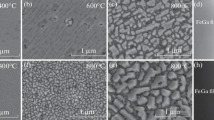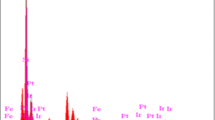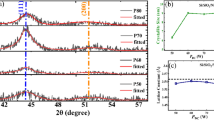Abstract
Fe20Ni80 thin films, with a thickness of 0.7 μm, were sputtered onto Si (111) single crystal and 40-μm thick Ni79Fe21 ribbons were fabricated using the rapid solidification process (RSP). Annealing of Ni-Fe thin films and ribbons at various temperatures showed that the stress induced during the sample fabrication was relieved with a subsequent decrease in coercivity, which was determined from the measurements of magnetic properties using a vibrating sample magnetometer (VSM). Decrease in coercivity of Ni-Fe thin films and ribbons were strongly dependent on annealing temperatures. Also noted was a high correlation between residual stress reduction at different annealing temperatures and coercivity that magnetic properties are strongly influenced by residual stress induced in samples.
Similar content being viewed by others
References
O. L. Boothby, “A new magnetic materials of high permeability,” J. Appl. Phys. 18, 173–176 (1947).
M. L. Trudeau, “Nanocrystalline Fe and Fe-riched FeNi through electrodeposition,” Nanostruct. Mater. 12, 55–60 (1999).
D. Kim, H. Matsuda, K. Aoki, and O. Takano, “Micro-structure and magnetic properties of electroless Ni-Fe-B films,” Plat. Surf. Finish. 83, 35–36 (1996).
T. Tadaki, Y. Murai, A. Koreeda, Y. Nakata, and Y. Hirotsu, “Structure and phase transformation of nano-scale particles of FeNi alloys,” Mater. Sci. Eng. A 217/218, 235–238 (1996).
L. J. Gao, P. Ma, G. W. Anderson, and P. R. Norton, “Composition and magnetic properties of Fe-Ni films electrodeposited on InP(100) and Si(111),” Proc. 4th Int. Symp. on Magnetic Materials, 1996, pp. 637–646.
K. Hara, S. Yamashita, H. Kaku, M. Ikeda, S. Kawano, T. Ohgai, T. Akiyama, H. Nakano, and H. Fukushima, “Magnetic properties of electrodeposited NiFe alloy films,” Proc. 2nd Int. Conf. on Processing Materials for Properties, 2000, pp. 239–242.
M. Ghorbani, A. Irajizad, A. Dolati, and R. Ghasempour, “The effect of the Cr and Mo on the physical properties of electrodeposited Ni-Fe alloy films,” J. Alloys Compd. 386, 43–46 (2005).
R. Szewczyk, A. Bienkowski, R. Kolano, “Influence of nanocrystallization on magnetoelastic Villari effect in Fe73.5Nb3Cu1S113.5B9 alloy,” Cryst. Res. Technol. 38, 320–324 (2003).
B. D. Cullity, Elements of X-ray Diffraction (Addison-Wesley, Reading, Mass., 1978).
ASM Handbook. Vol.2. Nonferrous Alloys and Special Purpose Materials (ASM Int., Materials Park, Ohio, 1990).
L. Néel, “Remarks on the theory of the magnetic properties of thin layers and fine grains,” J. Phys. Radium 17, 250–255 (1956).
Author information
Authors and Affiliations
Corresponding author
Additional information
The article is published in the original.
Rights and permissions
About this article
Cite this article
Kim, C.W., Cho, K.H. & Suk, H.G. A study of the effect of residual stress on magnetic properties of Fe-Ni thin film using a synchrotron X-ray. Phys. Metals Metallogr. 115, 1338–1341 (2014). https://doi.org/10.1134/S0031918X14130092
Received:
Accepted:
Published:
Issue Date:
DOI: https://doi.org/10.1134/S0031918X14130092




